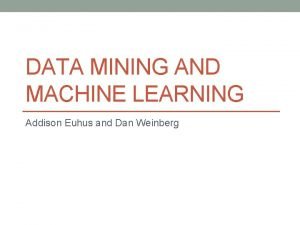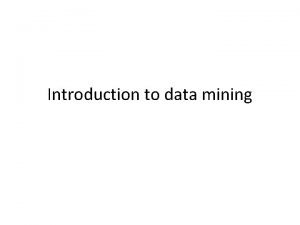DATA MINING AND MACHINE LEARNING Addison Euhus and











- Slides: 11

DATA MINING AND MACHINE LEARNING Addison Euhus and Dan Weinberg

Introduction • Data Mining: Practical Machine Learning Tools and Techniques (Witten, Frank, Hall) • What is Data Mining/Machine Learning? “Relationship Finder” • Sorts through data… computer based for speed and efficiency • Weka Freeware • Applications

Components of Machine Learning • Concept/Relation: What is being learned from the data set • Instances: “Input” • Attributes: “Values” • Nominal, Ordinal, Interval, Ratio • “Name, Order, Distance, Number”

The Output • Variety of forms depending on the concept to be learned • Can be a table, regression, chart/diagram, grouping/clustering, decision tree, or set of rules • Different output will describe different things about same set of data • Cross Validation

Some Algorithms in Machine Learning • Decision Trees (ID 3 Method) • Split an attribute into tree nodes and categorize the data and continue splitting into further nodes • Want to chose the attribute that is most “pure” – quantitatively speaking, most amount of “information” • Entropy(x, y, z) = -xlog 2(x)-ylog 2(y)-zlog 2(z), the amount of uncertainty in the data set • info([a, b, c]) = entropy(a/t, b/t, c/t) where t=a+b+c

Decision Trees Continued • Gain(Attribute) = info(unsplit) – info(split) • The attribute with the most gain should be split first in the decision tree algorithm • An example: Attribute Yes No No No Yes, Yes Gain = info([9, 5])-info([2, 3], [4, 0], [3, 2]) =. 247 Yes Yes No No

Other Algorithms • Covering Approach: • Creates a set of rules, unlike a decision tree • However, Same top-down, divide and conquer approach • Begin with the end values and then choose the attribute with the most “positive instances” • For ratio attributes, models such as line-of-best-fit and other regressions are used • Least-Squares regression

Instance-Based Learning • At run-time the program uses a variety of different calculations to find instances that are most similar to the test instance • Find the “nearest-neighbor, ” based off of “distances” • Measures “distances” and how close one instance is to another. The closest instances have their value assigned to the test instance • Standard Euclidean or alternative forms

Applications • Wine Quality Dataset • Nearest Neighbor: 65. 39% Accuracy • Decision Tree: 58. 25% Accuracy

Wine Quality Output Decision Tree Nearest Neighbor

A Challenging Classification Problem • Shortfalls and Limitations • Poker Hands: (Used with over 5, 000 different instances) • Decision Tree: 55. 90% • Nearest Neighbor: 46. 86% • Some speed algorithms: <35% The issue: Suit is numerical (0, 1, 2, 3) as well as the order the cards are presented in
 Addison euhus
Addison euhus Mining complex data types
Mining complex data types Machine learning and data mining
Machine learning and data mining Azure data mining
Azure data mining Mining multimedia databases in data mining
Mining multimedia databases in data mining Difference between strip mining and open pit mining
Difference between strip mining and open pit mining Text and web mining
Text and web mining Unsupervised learning in data mining
Unsupervised learning in data mining Pengertian unsupervised learning
Pengertian unsupervised learning Strip mining vs open pit mining
Strip mining vs open pit mining Mineral resources and mining chapter 13
Mineral resources and mining chapter 13 What is data mining and data warehousing
What is data mining and data warehousing





















